Physical Address
304 North Cardinal St.
Dorchester Center, MA 02124
The expertise and contribution of this chapter’s prior authors (Drs. Alvin C. Crawford and Charles T. Mehlman) are greatly appreciated.
Fractures and injuries about the foot and ankle in children are common and can have an important functional impact. Foot and toe fractures are among the top 10 pediatric orthopedic injuries, and physeal injuries about the ankle are the second most common growth plate fracture. A pain-free and deformity-free foot and ankle after injury allows a child the freedom to run, play, and explore the environment. If a residual deformity lingers after injury, the child limps, which causes distress for the parents, who may feel that they did not do enough to prevent their child’s problem. The child might be teased by peers and may have an arthritic problem that causes pain and leads to limitations later in life.
With increased and more competitive sports participation and activities, possible decreasing age for puberty, and increased functional demands, many older children and adolescents sustain adult-type injuries. Pilon fractures, syndesmotic injuries, Lisfranc fracture-dislocations, and comminuted fractures of calcaneus or talus are uncommon fracture patterns in children. For complex injury patterns that are not typical for pediatric patients, it would be beneficial to team up with adult orthopedic trauma specialists for optimal patient care. Our collected thoughts and those of our referenced colleagues are intended to guide the reader to a safe resolution of foot and ankle injuries in children.
The ankle joint is a true mortise joint, or a modified hinge joint, that consists of three bones: the tibia, fibula, and talus. The joint essentially moves in only one plane, from plantar flexion to dorsiflexion. The lateral malleolus allows minimal rotation to accommodate the changing width of the talar dome. The talar dome is broader anteriorly than posteriorly and, as a result, allows less rotation when the foot is in dorsiflexion than when it is in plantar flexion. The anatomic relationships and limited joint motion render the distal fibular epiphysis particularly vulnerable to crushing and twisting injuries ( Fig. 15.1 ).
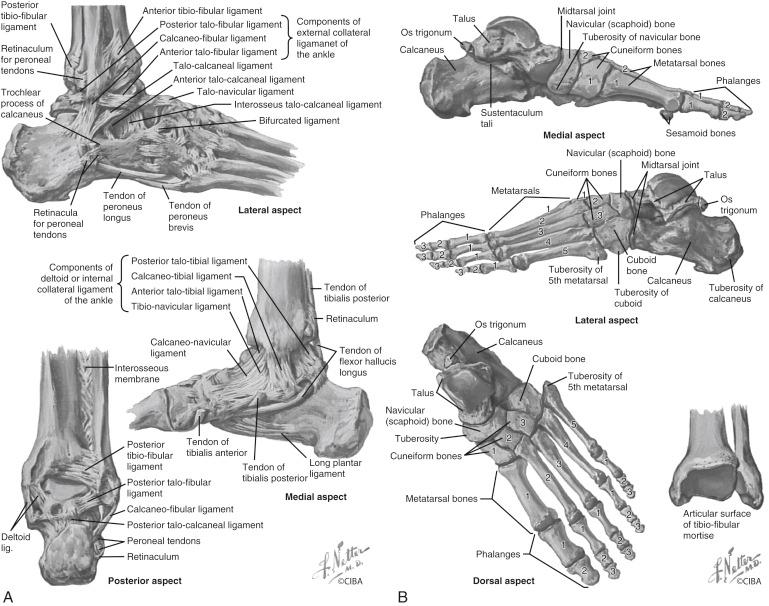
The ligaments about the ankle are attached to the epiphyses ( Fig. 15.2 ). The deltoid ligament arises from the tip of the medial malleolus distal to the growth plate; it consists of two sets of fibers—superficial and deep. The superficial fibers originate from the anterior portion of the medial malleolus (anterior colliculus) and span out to attach to the calcaneus, navicular, and talus. The deep portion of the deltoid ligament originates from the posterior portion of the medial malleolus (posterior colliculus and intercollicular groove) and inserts into the medial surface of the talus. On the lateral aspect of the ankle, support is provided by three separate ligaments. Their tension and spatial orientation change according to the position of the ankle joint: plantar flexion, neutral, or dorsiflexion. These ligaments have their origin on the fibula distal to the physis. The anterior talofibular ligament runs anteriorly and medially from the anterior margin of the lateral malleolus to the talus anteriorly. The posterior talofibular ligament runs horizontally from the sulcus on the back of the lateral malleolus to the posterior aspect of the talus. The calcaneofibular ligament extends downward and slightly posterior from the tip of the lateral malleolus to a tubercle on the lateral aspect of the calcaneus; it is in close relationship to the peroneal tendons and their sheath. In general, the growth plate is more likely than the ligaments to fail during the years of skeletal development because of tensile weakness in the growth plate.
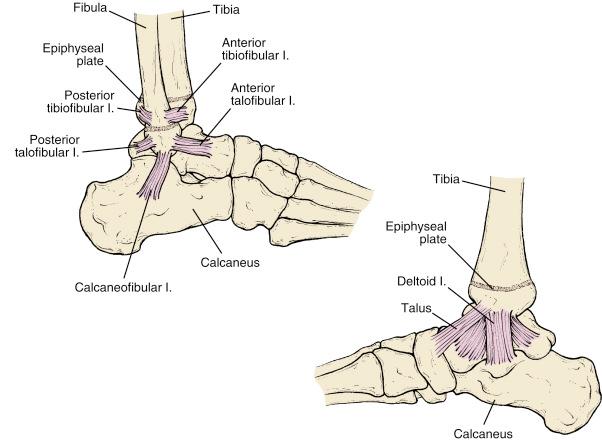
The tibiofibular syndesmosis consists of four ligaments—the anterior and posterior inferior tibiofibular ligaments, the interosseous ligament, and the anterior transverse ligament—in addition to the interosseous membrane. The anterior tibiofibular ligament runs downward between the anterior margin of the tibia and fibula; its origin in the fibula is also distal to the growth plate. The tibiofibular syndesmosis is rarely injured in children because the ligament is stronger than the growth plates, which tend to give more easily. In an adolescent in whom the growth plate has closed, disruption of the tibiofibular syndesmosis can occur.
The distal tibial physis begins to close about 18 months before complete cessation of tibial growth, first closing in its midportion, then medially, and finally laterally. Longitudinal growth of the distal tibial epiphysis ceases at about 12 years of age in girls and 13 years in boys. The fusion process does not occur uniformly but is instead asymmetric ( Fig. 15.3 ). Fusion begins in the area of the tibial “hump,” which is located centrally and is seen on the anteroposterior (AP) view as a small bump over the area of the medial edge of the talus. As fusion progresses, the medial part of the plate closes and then progresses posteriorly; finally, the anterolateral part of the plate fuses. The average time to fusion is 18 months. The fused part of the epiphyseal plate is no longer weak and prone to fracture but becomes an area of relative strength. The irregular fusion pattern and the resulting areas of relative strength and weakness are responsible for the unusual transitional fracture patterns; specifically, juvenile Tillaux and triplane fractures.
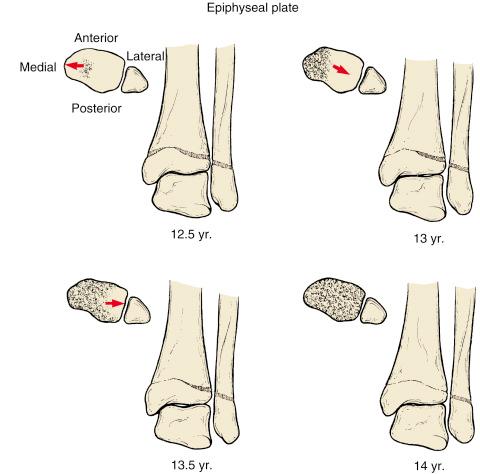
Accessory ossicles of the malleoli are common in skeletally immature individuals. They usually appear between the ages of 7 and 10 years and eventually fuse with the secondary ossification center of the malleolus at skeletal maturity. The lateral ossicle has been termed the os subfibulare , and the medial ossicle is termed the os subtibiale ( Fig. 15.4 ). Most of these ossification variations are identified only fortuitously, when radiographs are taken to evaluate an injury to the ankle or foot. They may represent remote injury or may be confused with a sleeve fracture-avulsion of the lateral or medial malleolus. If the patient is symptomatic and the presence of a lesion is uncertain, a contralateral ankle radiograph can help differentiate ossification variant from an avulsion fracture. A positive magnetic resonance image (MRI) after failure of nonoperative treatment may support a diagnosis of injury.

Ankle fractures account for 5% of childhood fractures. Injuries are commonly caused by indirect violence in which the fixed foot is forced into eversion-inversion, plantar flexion, external rotation, or dorsiflexion. Fractures may also be sustained by direct violence: the history is then usually an automobile accident, a fall from a height, or participation in contact sports. Injuries to the lower part of the leg and foot are more common in boys and usually occur between the ages of 10 and 15 years. Those about the ankle constitute 10% to 25% of all physeal injuries. The distal tibial epiphysis is the second most common site of epiphyseal fracture in children, after the distal end of the radius. The bone of a child is more capable of elastic and plastic deformation than is an adult bone. Ligamentous injuries have traditionally been considered to be rare because the ligaments are stronger than the physes, but a recent prospective cohort study has shown that a combination of lateral ligament and bony injury coexists in 90% of suspected Salter-Harris type I fractures of the distal fibula. The forces are transmitted to the medial part of the tibia by the ligamentous pull of the deltoid ligaments. Laterally, forces are transmitted by the anterior and posterior tibiofibular ligaments, the anterior and posterior talofibular ligaments, and the calcaneofibular ligaments. The tendency for physeal compression during adduction injury is also greater. With an adduction injury, medial migration of the talus is usually blocked by the medial malleolus, and the medial malleolus is subsequently fractured.
The prognosis for injuries to the foot and ankle involves several criteria. The skeletal maturity of the patient determines the resulting bone, ligament, and/or growth plate injury. At different skeletal ages, the same mechanical twisting, torsional force, or related trauma to the foot and leg causes different injuries. Children are more prone to epiphyseal injuries, which, of course, are subject to more complications than are shaft or metaphyseal injuries. The more severe the injury (e.g., open fracture, grossly contaminated, or comminuted with or without soft tissue crushing), the greater the possibility of secondary devitalization with consequent delayed union, nonunion, pseudarthrosis, or osteomyelitis. The adequacy of reduction directly influences the rate of union; less healing time is required when bone contact is more. In addition, anatomic reduction is especially important for growth plate fractures because anatomic alignment reduces the incidence of angular deformity and shortening secondary to growth arrest, as well as degenerative arthritis secondary to persistent joint incongruity and instability. The prognosis after fractures involving the distal end of the tibia in children depends on the skeletal maturity of the patient, the severity of the injury, the fracture type, the degrees of comminution and displacement of the fracture, and the adequacy of reduction.
In recent years, clinical prediction rules that focus on eliciting bony tenderness have led to refinement in the use of plain film radiography of the pediatric ankle; that is, the need for radiography has been reduced by approximately 25% without missing any fractures. Although some institutional variation has been reported, multiple studies have now shown that both doctors and nurses can effectively apply such decision rules (also referred to as ankle rules) in ambulatory care settings. As per “low-risk ankle rules” in children, if tenderness or swelling is only confined to the distal fibula or adjacent lateral ligaments, then ankle radiographs are not required. As per “Ottawa ankle rules,” ankle radiographs are required if there is pain near the malleoli and one or more of: inability to bear weight; bony tenderness at the posterior edge; or bony tenderness at the tip of either malleolus. In a prospective comparative study, there was 63% reduction in requirement of ankle radiographs using low-risk ankle rules, compared with only a 12% reduction using the Ottawa ankle rules. Despite these ankle rules, most institutions in North America would recommend standard three-view (i.e., AP, lateral, and mortise) radiographs for evaluation of ankle injuries. Consideration may be given to more selective use of radiographs during follow-up of known injuries.
Besides evaluation of bones and joints on radiographs, one should assess the soft tissue very carefully. The normal fat stripe surrounding a bone may be thickened after a nondisplaced fracture. In addition, joint effusion after nondisplaced articular fractures may result in a positive fat pad, or synovial sign, especially in the anterior aspect of the ankle over the talar neck or posteriorly, with displacement of the Achilles tendon fat stripe ( Fig. 15.5 ).
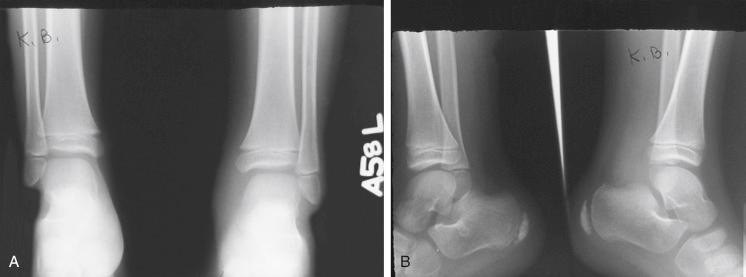
Computed tomography (CT) is recommended for imaging intraarticular fractures. CT scan can better define the fracture geometry and help measure articular gap, step-off, or displacement. It can also help in surgical planning for size, number, and trajectory of implant placement, especially when percutaneous approach is planned. In a study focused on triplane fractures, compared with radiographs, raters changed the definition of the fracture pattern in 46% of cases, degree of displacement in 39%, treatment plan in 27%, and either the number or orientation of screws in 41% of cases after reviewing the CT. Paradoxically, a European survey of surgeons revealed that 50% used CT selectively and only 38% used CT routinely in their management of triplane fractures. This may simply reflect a high level of confidence in allowing orthopedic plain-film interpretation to drive surgical decision-making. In an adult cadaver Tillaux fracture setting, plain radiographs were shown to be accurate to within 1 mm 75% of the time, whereas CT achieved this goal only 50% of the time. However, CT was more sensitive than plain radiographs in detecting fractures with greater than 2 mm of displacement. It must be remembered that, in contrast to plain radiography, CT exposes the child to substantial amounts of radiation. Newer CT imaging protocols have tried to minimize radiation. The newer cone-beam CT (CBCT) radiation dose is similar to that of an adult extremity radiograph, and its application has been studied in pediatric foot and ankle injuries. Other advantages of CBCTs are their dynamic capabilities to scan the extremity in weightbearing position and possible installation in the clinic for easy access.
MRI utility in acute pediatric foot and ankle injuries is conflicted in the literature. Intraarticular bone fragments of unknown origin on radiographs could be further evaluated by MRI. After treatment, if the patient has any stiffness or ankle instability, MRI is indicated to exclude any intraarticular cartilaginous (silent) fragments or severe ligamentous injury, respectively.
When fractures about the ankle in children are monitored, it is extremely important to observe the Park-Harris growth arrest lines. These lines represent transient calcification of physeal cartilage during injury repair and are an excellent marker for observing growth after injury. The lines are parallel to the physis if growth is occurring normally ( Fig. 15.6 ). In children with physeal damage, the line may be tented or angular.
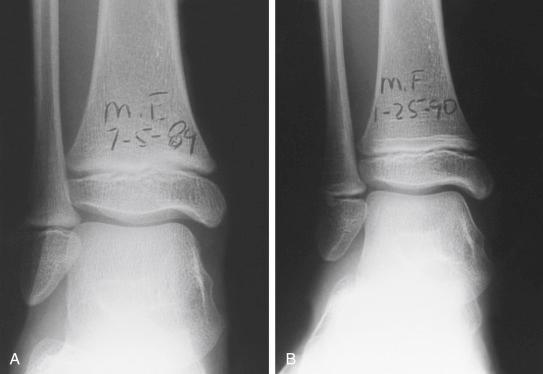
In 1978, Dias and Tachdjian introduced a classification of children’s fractures that incorporated the concepts of Lauge-Hansen adult classification. To classify the fracture properly, radiographs are necessary; AP, lateral, and mortise views must be taken. In their classification ( Table 15.1 ), the first part of the type name describes the position of the foot at the moment of trauma, and the second notes the abnormal force applied to the ankle joint: supination-inversion, pronation-eversion/external rotation, supination-plantar flexion, or supination-external rotation ( Fig. 15.7 ).
| Type | Grade | Position of Foot | Injuring Force | Pattern of Fracture | Comment |
|---|---|---|---|---|---|
| Supination-inversion | 1 | Supinated | Inversion | Usually Salter-Harris type I or II fracture-separation of the distal fibular physis Occasionally rupture of the lateral ligament or fracture of the tip of the lateral malleolus |
Displacement minimal and almost always medial |
| 2 | Supinated | Inversion | Usually Salter-Harris type III or IV fracture of the medial part of the tibial epiphysis Rarely Salter-Harris type I or II fracture with medial displacement of the entire tibial epiphysis |
Caution: Risk of up to 50% growth arrest without surgery, 2% with surgery | |
| Supination-plantar flexion | 1 | Supinated | Plantar flexion | Commonly Salter-Harris type II fracture of the tibial epiphysis Rarely Salter-Harris type I fracture of the tibial physis No associated fracture of the fibula Metaphyseal fragment and displacement posterior Fracture line is best seen on a lateral radiograph |
Prognosis good Caution: Do not damage growth plate by forced manipulation Posterior displacement will remodel |
| Supination-external rotation | 1 | Supinated | External rotation | Salter-Harris type II fracture of the distal tibial epiphysis with long spiral fracture of the distal tibia starting laterally at distal tibial growth plate | Up to 35% risk of distal tibial growth arrest |
| 2 | Supinated | External rotation | Grade 1 plus spiral fracture of the distal fibular shaft | ||
| Pronation-eversion/lateral rotation | 1 | Pronated | Eversion-lateral rotation | Salter-Harris type II fracture of the distal tibial epiphysis Metaphyseal fragment lateral or posterolateral Displacement lateral or posterolateral |
Greater than 50% risk of distal tibial growth arrest |
| 2 | Fibular fracture short, oblique, 4–7 cm from tip of the lateral malleolus | ||||
| Miscellaneous | |||||
| Adolescent Tillaux | — | Neutral? | Lateral rotation | Salter-Harris type III fracture of the lateral part of the distal tibial epiphysis Should not be any metaphyseal fragment Displacement anterolateral |
Medial part of the distal tibial physis closed |
| Triplane, three fragments | — | ? | Lateral rotation | Fracture in three planes—coronal, sagittal, and transverse Combination of Salter-Harris types II and III Fracture produces three fragments |
Medial part of the distal tibial physis open |
| Triplane, two fragments | — | ? | Lateral rotation | Fracture in three planes—coronal, sagittal, and transverse Combination of Salter-Harris types II and III |
Medial part of the distal tibial physis usually closed |
| Comminuted fracture of the distal end of the tibia | — | ? | Crushing injuries Direct violence |
Comminuted fracture involving the distal tibial epiphysis Physis often damaged Fibula fracture at various levels |
Poor prognosis |
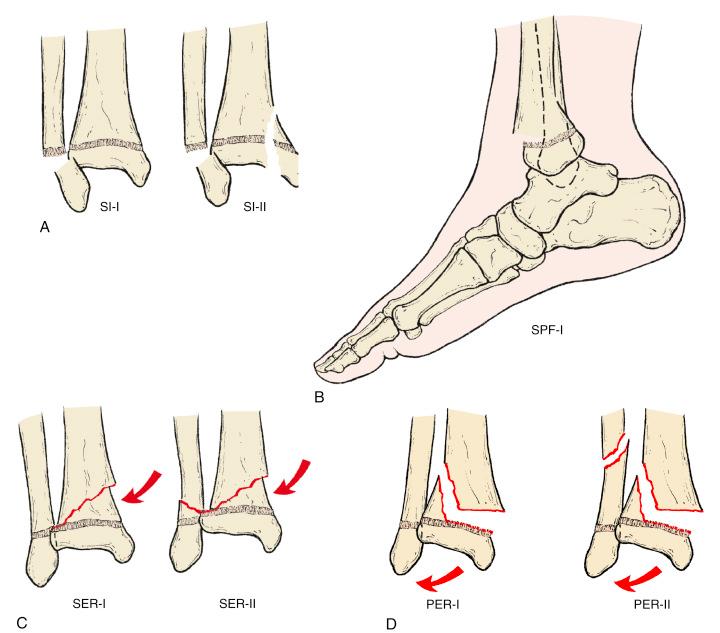
The Salter-Harris classification has been used for fractures of the distal end of the tibia. It is familiar and easier to use compared with Dias-Tachdjian classification. Spiegel and colleagues ( Fig. 15.8 ) monitored 184 of a series of 237 fractures of the distal end of the tibia, fibula, or both for an average of 28 months after injury. Using the Salter-Harris classification, they differentiated three groups according to their risk of shortening of the leg, angular deformity of the bone, or incongruity of the joint. The low-risk group consisted of 89 patients, 6.7% of whom had complications; this group included all type I and type II fibular fractures, all type I tibial fractures, type III and type IV tibial fractures with less than 2 mm of displacement, and epiphyseal avulsion injuries. The high-risk group consisted of 28 patients, 32% of whom had complications; this group included type III and type IV tibial fractures with 2 mm or more of displacement, juvenile Tillaux fractures, triplane fractures, and comminuted tibial epiphyseal fractures (type V). The unpredictable group consisted of 66 patients, 16.7% of whom had complications; only type II tibial fractures were included. The incidence and types of complications were correlated with the type of fracture (Carothers and Crenshaw classification), the severity of displacement or comminution, and the adequacy of reduction.
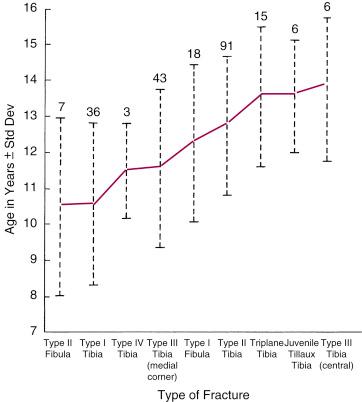
Despite their complexity, ankle fractures in children can be roughly divided into avulsion and epiphyseal fractures. Adequately reduced avulsion fractures can be expected to heal well; epiphyseal fractures, however, may give rise to late complications. Vahvanen and Alto proposed that classification of ankle fractures in children be based on radiographic findings, primarily with respect to epiphyseal lesions, and on a simple grouping with regard to risk for clinical purposes: group I, low-risk avulsion fractures and epiphyseal separations; and group II, high-risk fractures through the epiphyseal plate. The authors agree with this simplistic concept. Most avulsion fractures in children heal very well and have few complications; those that involve the epiphyseal plate tend to lead to either failure of continued growth because of damage to the endochondral ossification sequence or the potential for arthritis from intraarticular gaps or step-offs greater than 2 mm.
Primary indications for surgical treatment include open fractures, inability to obtain or maintain adequate closed reduction, displaced articular fractures, displaced physeal fractures, or massive soft tissue injury.
Every effort should be made to reduce the fracture anatomically and obtain accurate alignment of the physis and articular surface. It is strongly recommended that most displaced injuries be treated under general anesthesia with adequate muscle relaxation. During reduction maneuvers, more traction and less manipulation would help to minimize further injury to the physis.
If anatomic reduction can be achieved by closed manipulation, consideration should be given to stabilizing the fracture with percutaneously placed cannulated screws or Kirschner wires. The goals are quite clearly anatomic reduction and stable internal fixation. Indirect reduction as an adjunct to closed manipulation is extremely effective in treating children’s ankle fractures. It is most effective when the fracture is fresh or before an interfragmentary clot has formed. Indirect reduction of medial malleolar and Tillaux fractures can be performed by using a guide pin through the distal fragment as a levering device, or “joystick,” to anatomically align the fragment; direct manual compression is then applied, and the pin is advanced across the fracture site. Percutaneous placement of pointed reduction forceps can help to achieve reduction and compression if required ( Fig. 15.9 ). Once anatomic reduction is achieved, partially threaded cannulated screw can be placed over the pin and across the fracture to achieve compression and maintain stability. Depending on the size of the fracture fragment, K-wires may be used for definitive fixation. Ankle arthroscopy can be used as an adjunct for assessment and treatment of articular surface injuries involving the distal tibia or the talar dome, or to address intraarticular osteochondral fragments ( Fig. 15.10 ).
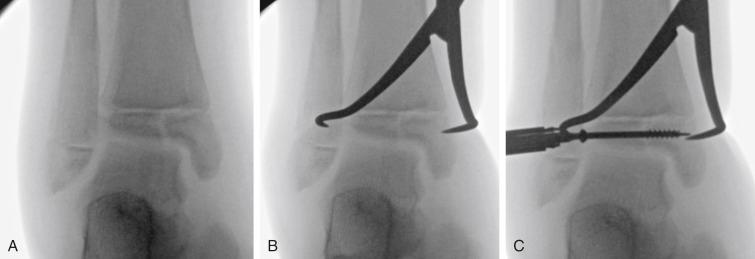
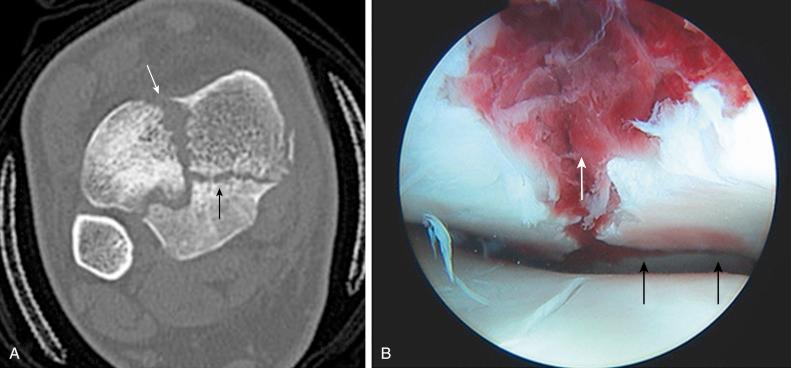
If one has to perform open reduction for intraarticular fracture, adequate exposure of the physis and the articular surface would help. Every effort should be made to diminish the amount of soft tissue dissection by placing the incision over the area of the fracture gap. One can usually encounter tear of the periosteum at the level of the fracture, and little additional dissection is necessary. Surgery should be performed in a physeal-respecting manner, and one should avoid putting instruments in the physis or forcefully manipulating the physis. By irrigating the wound, removing any clots, and extracting any bony debris by gentle curettage, it is usually possible to realign the fracture anatomically. If anatomic reduction is prevented by a small metaphyseal fragment, such as that found with a Salter-Harris type IV fracture, it is possible to remove the metaphyseal fragment and obtain anatomic alignment of the epiphysis without damaging the physeal line. On occasion, a periosteal flap may prevent adequate reduction and may need to be extracted from the fracture site. Once anatomic alignment has been achieved, one could temporarily pin the epiphysis to the intact portion of the epiphysis and, if the metaphyseal fragment is large enough, then metaphysis to the metaphysis. Definitive fixation using cannulated screw can then be performed across the epiphysis and the metaphyseal fragment. The authors strongly recommend against placing a screw obliquely across the physis in a growing child. Unless evidence of closure of the middle of the physis is seen, the authors would not place an oblique screw across the fracture site as placed in adults for medial malleolar fractures. If the fracture geometry requires placement of hardware across the physis, then smooth K-wires could be used instead of a screw. Transarticular pins or multiple passes across the physis should be avoided ( Fig. 15.11 ).
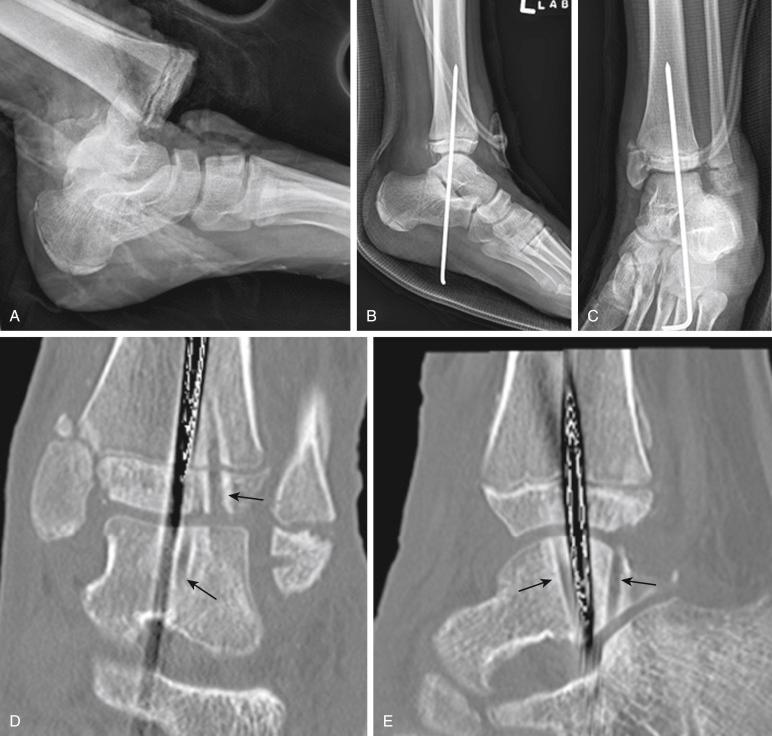
The Dias-Tachdjian pediatric ankle fracture classification has stood the test of time as a useful tool for categorizing and understanding these injuries. The authors would estimate that this classification system easily accounts for more than 90% of the nontransitional ankle fractures encountered in children. Outcome studies have also indicated prognostic differences among the various categories and the ability of surgical intervention to improve treatment results. Universal agreement does not exist because some authors have emphasized that the risk of growth arrest may simply be linked to higher-energy injuries. Other authors have also voiced skepticism about the ability of surgery to reduce the overall risk of growth arrest.
The supination-inversion mechanism is considered to be the most common of the pediatric ankle fracture patterns. This makes immediate sense because the first stage of this injury pattern is a Salter-Harris I or II fracture of the distal fibula (usually nondisplaced), a ubiquitous fracture in pediatric orthopedic trauma clinics. At times this injury may amount to a physis-opathy or physis-itis (which amounts to a stress fracture) of the distal fibular growth plate. More commonly, the radiographic appearance of the osseous distal fibula is normal, and pain, tenderness, and swelling (“goose egg”) on clinical examination make the diagnosis.
For distal fibular physeal fracture, recent literature has challenged the previous notion that physis, being weaker than ligament, is more prone to injury in children and adolescents. There is now some evidence that Salter-Harris type I fracture of the distal fibula is not as common as was previously reported. In a prospective study of 135 children with lateral ankle injury, normal radiographs, and MRI, only 4 patients had true physeal fracture of the distal fibula; 108 (80%) had ligament injuries (ankle sprain), and 27 (22%) had bone contusions. Some 35% of those with ligamentous injury were found to have an associated occult fibular avulsion fracture. There was no difference in outcomes when all patients were treated with a removable ankle brace for a month. These findings can decrease the overtreatment of these injuries.
The second stage of this injury, after bony or ligamentous injury on the lateral side, involves a Salter-Harris type III or IV injury of the medial malleolus. This typically attracts much attention, but it must be remembered that the distal fibula fractures first and the medial malleolus fractures second. After separation of the distal fibular epiphysis, the inversion-adduction force of the talus striking the medial malleolus produces the resultant fracture pattern. Radiographs typically show the fracture to involve less than one-third of the mediolateral distance across the epiphysis because the fracture line extends vertically to the physis and exits medially through the physis ( Fig. 15.12 ). Determining the precise extent of displacement in these fractures is crucial because a significant gap may lead to nonunion, delayed union, or growth arrest. As the fracture unites, the ossification process above and below the physis may span the growth plate and form a bony bridge anchored in the metaphyseal and epiphyseal calluses. The width and, in turn, the strength of that bridge depend on the size of the residual interfragmentary gap. A thin, weak bridge after Salter-Harris III or IV fracture of the medial malleolus in a young patient (<10 years of age) may break spontaneously, and normal growth may continue.
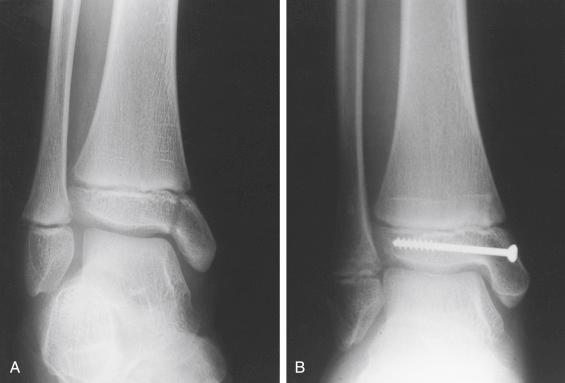
As mentioned earlier, the medial malleolar fracture fragment (either a Salter-Harris type III or IV) usually attracts the most attention, and most of the following discussion focuses on it. In the past, when these fractures were treated via closed reduction and cast immobilization, the rate of growth arrest (particularly of the medial malleolar growth region) may have often exceeded 50%. However, with current concepts of anatomic reduction and stable internal fixation, these growth-related complications may be seen in as few as 2% of patients. Thus the precedent for surgical treatment is rather strong in this fracture pattern.
For a displaced medial malleolar fracture, either closed or open reduction and internal fixation is the preferred treatment. A percutaneous cannulated screw can be inserted in the epiphysis quite neatly and allows excellent control if closed reduction to within 2 mm is achieved ( Fig. 15.12 ). In soft bone, a washer can be used as a one-hole plate to distribute forces generated by the screw head, thus allowing the possibility of greater interfragmentary compression. However, a washer can be prominent and may require later hardware removal if it leads to irritation. If logistically possible, percutaneous procedures are less traumatic and result in less operative exposure with less potential for vascular compromise and infection. Most of these fractures have remarkably small Thurston-Holland (metaphyseal spike) fragments that do not lend themselves to fracture fixation. Rarely, the articular surface may have comminution or marginal impaction ( Fig. 15.13 ). If in doubt, a preoperative CT scan can help to identify this. For such fractures, the articular surface is aligned using open reduction techniques, and the smaller articular fragments can be held by small (0.035 or 0.045 inch) K-wires. These wires can be embedded in bone or pulled out from the lateral side and cut outside the skin for later removal after fracture healing. They can be supported by screws using the raft technique. In a minority of cases, the fibula may merit formal reduction and smooth K-wire fixation.
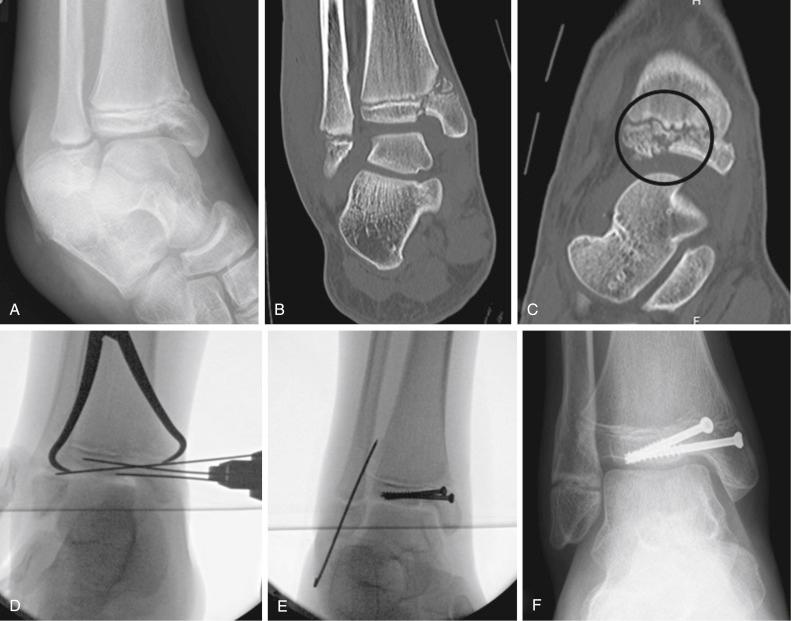
After reduction and stable internal fixation of the medial malleolar fragment and after appropriate attention to the distal fibular fracture, non-weightbearing cast immobilization is added for about 4 weeks. Routine hardware removal is controversial. The recommendation for removing epiphyseal screws is based on a cadaveric study that showed that subchondral distal tibia screws increased peak contact pressure and force across the tibiotalar joint. In clinical practice, however, the authors do not routinely remove the epiphyseal screws and have not encountered any problems by retaining the implants permanently. If a decision is made to remove the screw, it should be performed in the first year. After that, screw removal may be challenging if bony growth covers the screw head. Removing such a screw late may then subject the extremity to more trauma than simply leaving it in place. The authors have no experience with the use of bioabsorbable implants for the management of these fractures, although reported study has not shown any differences in the rate of nonunion, unplanned secondary surgeries, or complications between bioabsorbable and metal screws. Certainly, in selected cases, closed reduction and cast immobilization of this injury may be successful when the fracture is not displaced and anatomic reduction is maintained.
This pediatric ankle injury pattern has been recognized for quite some time. The supination-external rotation mechanism is considered to first result in a physeal fracture of the distal tibia that typically has a rather large and medially based (to posteromedially based) Thurston-Holland fragment. Continuation of these injury forces results in a nonphyseal fracture of the distal fibula. This pediatric injury pattern mimics the adult pattern of the same name in that, when the fibula is involved, its distal diaphyseal fracture line extends along an anterodistal-to-posteroproximal line ( Fig. 15.14 ).
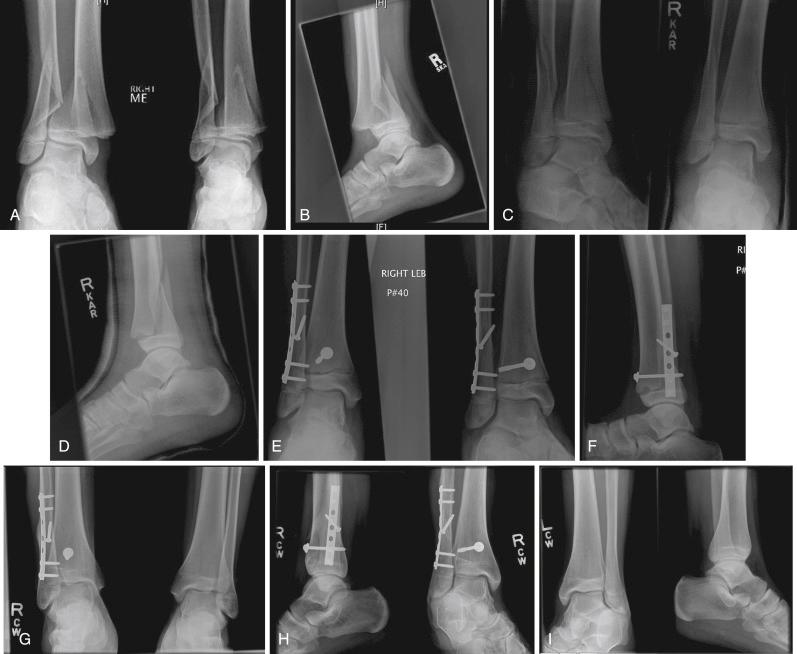
The displacement of the supination-external rotation injury is typically not subtle. The ankle is swollen and painful, and the deformity is obvious. The apex of the deformity is usually anterolateral, and the previously mentioned oblique-to-spiral-oblique fibular fracture is virtually always present. Interposed periphyseal periosteum is certainly a possibility but has a somewhat lower likelihood simply because of the large size of the associated Thurston-Holland fragment. Anatomic reduction is the goal, with axial forces being applied via manual calcaneal traction and a variable amount of internal rotation followed by dorsiflexion. Postreduction images must be critically evaluated with respect to restoration of overall anatomic ankle alignment, significant residual physeal widening, and persistent fibular displacement.
The treating orthopedic surgeon must decide how much displacement is acceptable in these supination-external rotation injuries. These extraarticular fractures are very different from the displaced intraarticular fractures of the previously discussed supination-inversion category. Nonetheless, concern exists about premature distal tibial growth arrest because of residual physeal displacement and abnormal joint forces secondary to fibular malunion. The amount of displacement that may trigger surgical intervention may be as little as 3 mm of physeal gapping and 2 mm or more of fibular displacement (shortening). Barmada et al reported the rate of premature physeal closure after Salter-Harris type I and II distal tibial fractures to be 60% if there was more than 3 mm residual physeal gap after fracture reduction, and the rate decreased to 17% if there was no residual gap. They recommended open reduction of these fractures to remove interposed periosteum if residual gap after fracture reduction was more than 3 mm. Subsequent study by the same group, however, did not report any significant change in the rate of premature physeal closure based on residual fracture gap or operative intervention. The authors do not recommend routine removal of interposed periosteum unless it is required to obtain satisfactory fracture alignment. Literature documenting the remodeling potential of these Salter-Harris type II fractures is scarce. It has been suggested in the literature that a premature physeal closure rate for this injury pattern could be as high as 35%. Thus, anatomic reduction and stable internal fixation is becoming more common than in the past. The large Thurston-Holland fragment associated with these injuries lends itself to stable internal fixation with one or even two cannulated screws.
If the fibular fracture remains displaced or if increased stability at the ankle is deemed necessary, especially in adolescents, then the fibular fracture can be treated with open reduction and internal fixation using lag screw and neutralization plate. Adult literature has reported on abnormal tibiotalar joint forces after fibular malunion, but this has not been studied in children. The authors do not routinely stabilize the fibula in children.
The pronation-eversion- external rotation fracture pattern was originally described by Dias and Tachdjian as a single stage injury, almost as if the respective tibial and fibular injuries occurred at the same time. However, it is commonly taught that this pediatric ankle fracture involves fracture of the distal tibial growth plate first (frequently with a rather small but easily seen laterally based Thurston-Holland fragment) followed by a rather transverse and substantially higher fracture of the fibular diaphysis ( Fig. 15.15 ). Once again, this fibular fracture more closely mimics the fibular fracture associated with the adult pronation-external rotation ankle fracture pattern. Displacement of this pediatric ankle fracture is almost never subtle in that the translation (lateral) and angulation (apex medial) of the distal tibial epiphyseal fragment is substantial; angulation (apex medial) of the fibular shaft fracture is equally impressive.
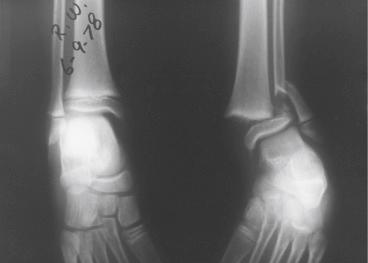
Carothers and Crenshaw expressed their greatest concern for growth arrest after pronation-external rotation injuries. These concerns have been echoed by contemporary authors as premature physeal closure rates that exceed 50% have been reported. As mentioned earlier, removal of interposed periosteum to decrease residual physeal gap after fracture reduction is controversial, unless it is required for satisfactory fracture alignment ( Fig. 15.16 ). An impediment to anatomic reduction (besides interposed periosteum) could be interposed tibialis posterior tendon ( Fig. 15.17 ). A high-energy mechanism of injury has also been implicated in growth arrest of such ankle fractures. Such concerns led to Carothers and Crenshaw’s reduction of these injuries under anesthesia and their selective use of internal fixation (even in 1955). For the typical fracture pattern of the tibia with small metaphyseal fragment, one or two smooth K-wires across the physis are usually sufficient for fracture stabilization. If the Thurston-Holland fragment is large enough, then screw fixation across the metaphyseal fragment could be performed ( Fig. 15.17 ). Standard plate fixation of the fibular fracture may add to the stability of the construct, if needed.

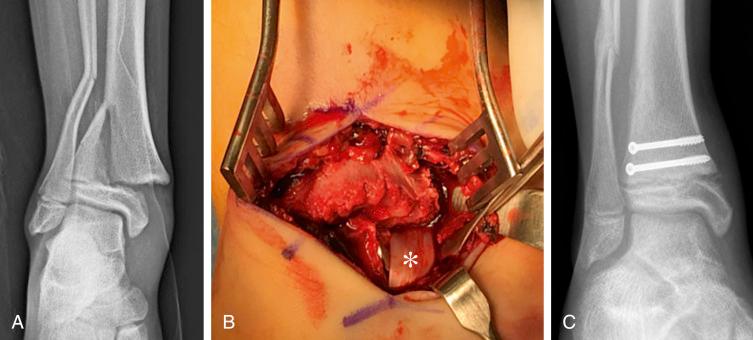
This is the only mechanism that is considered to result in a displaced growth plate fracture of the distal tibia without any associated fibular fracture. The tibial Thurston-Holland fragment is variable in size but is predominantly posterior in location. It is clear from multiple published series that this plantar flexion injury is the least common of the pediatric ankle injury patterns. Displacement is also typically subtle, and the lateral radiograph is the most likely to show mild widening of the tibial physis ( Fig. 15.18 ). It is controversial if removal of interposed periosteum would decrease the rate of physeal closure. No special studies are required for this injury because the diagnosis is fairly straightforward.
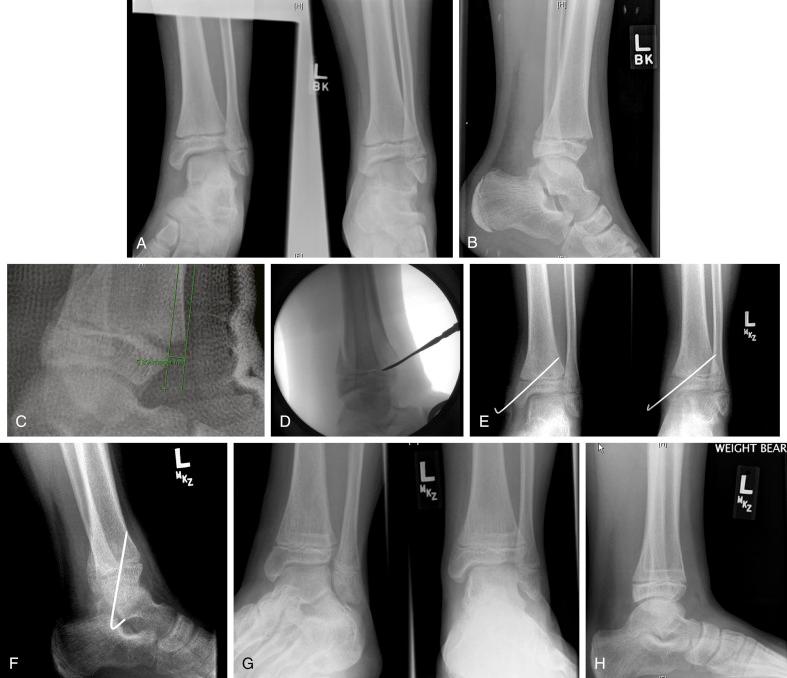
Growth arrest after the supination-plantar flexion mechanism can occur even after undisplaced fracture. The reported rate of growth disturbance has been 24%. The treating surgeon’s decision must be guided by an appreciation of the amount of physeal displacement and estimation of the amount of remaining growth. Clearly, there is little need for reduction of mild residual physeal displacement aimed at decreasing the likelihood of growth arrest in a patient with very little remaining growth. If it is determined that significant growth remains and the surgeon opts for surgical treatment, removal of interposed periosteum could be considered, because it is fairly common in this injury pattern ( Fig. 15.18 ). After anatomic reduction, internal fixation may often be achieved with smooth K-wire across the physis or with a cannulated screw in the posterior metaphyseal fragment if the fragment is large enough. Non-weightbearing cast immobilization is indicated for several weeks after surgery for purposes of pain control and fostering undisturbed fracture healing.
The Salter-Harris type V injuries are extremely rare and appear to result from axial compression. These injuries supposedly cause partial or complete physeal arrest by virtue of a crush injury to the germinal cells of all or a portion of the physis. In such an injury, no obvious fracture of the epiphysis or metaphysis can be found, and the initial radiograph may show no evidence of injury. The diagnosis of a type V injury is therefore a retrospective one made only after premature closure has been established in a growth plate that was previously considered uninjured ( Fig. 15.19 ). It is believed that this injury causes unrecognized damage to physeal cells either directly or secondary to injury to the blood supply of the germinal cell layer of the physis.
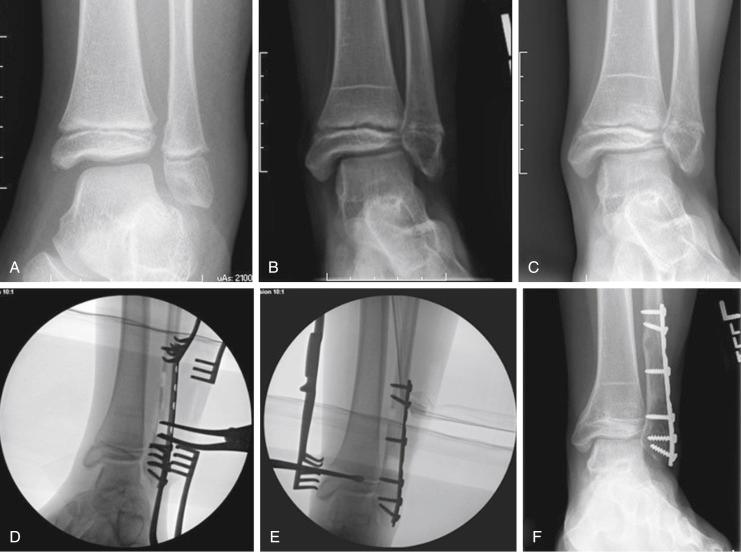
Two cases of tibial fracture have been reported in which symmetric premature closure of the entire proximal tibial physis caused a leg-length discrepancy without any angular deformity. A compression injury to the entire physis would be unlikely unless a uniform longitudinal force were the mechanism of injury, as in a fall from a height. However, the clinical history and the configuration of the associated fractures were not consistent with a purely longitudinal force in their cases. Peterson and Burkhart believed the proposition to be speculative that premature closure of the growth plate results from compression at the time of the accident. Because the two cases cited by Salter and Harris did not have a normal radiographic appearance at the time of injury, another fracture type could have been present. These investigators further concluded that all type V injuries reported in the literature involved the knee. On review of the literature, they concluded that the common factor in all these conditions, including the trauma cases, seemed to be prolonged immobilization. Thus, an intriguing possibility is that posttraumatic physeal fusion is not always caused by direct damage to the growth plate at the time of injury but rather by factors associated with immobilization, like ischemia.
Ablation of the perichondrial ring has been categorized as a type VI injury. Avulsion or compression injury to the periphery of the physis is rarely seen. Lawn mower injuries and degloving injuries, which occur when the leg is dragged across concrete or pavement, may remove the perichondrial ring ( Fig. 15.20 ). The ensuing callus may cause the development of a bridge between the metaphysis and epiphysis as described by Rang. The ankle would drift progressively into varus.
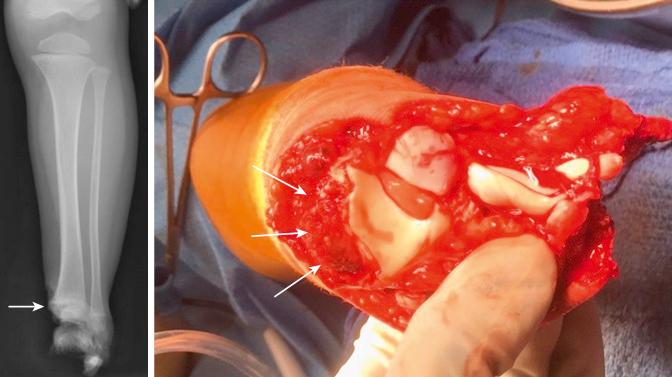
Transepiphyseal fractures (type VII fracture) are uncommon and have to be differentiated from os subfibulare. In a study comparing 11 patients with type VII distal fibular intraepiphyseal fracture to 12 patients with os subfibulare, the authors provided diagnostic radiographic criteria to differentiate these two injuries. Type VII fractures had long, irregular fracture line through the middle third of the distal fibular epiphysis, and those with symptomatic os subfibulare had a smooth-edged ossicle within the inferior third of the epiphysis. It is important to differentiate between these two entities because it has treatment implications ( Fig. 15.21 ).
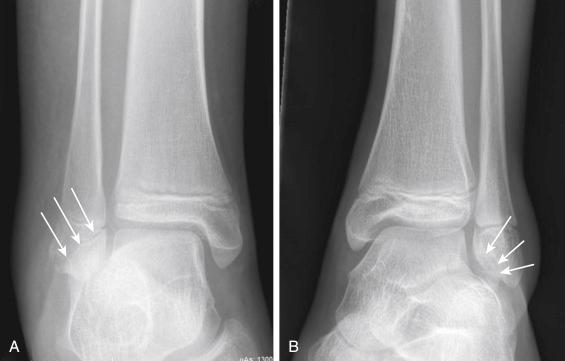
Letts et al reported on eight pilon fractures in seven adolescents with a mean age of 15 years, 10 months. A pilon fracture was defined as a fracture of tibial plafond with displacement of tibial articular surface greater than 5 mm with variable comminution and variable involvement of the fibula and the talus. All patients were treated with open reduction and internal fixation ( Fig. 15.22 ). There were three poor results as a result of posttraumatic arthrosis in two cases (necessitating ankle arthrodesis) and residual distal tibial articular deformity in one patient. Another patient with a growth arrest did not have any clinical implications because of him being near skeletal maturity. The results demonstrate difficulty in treatment of this subset of patients.
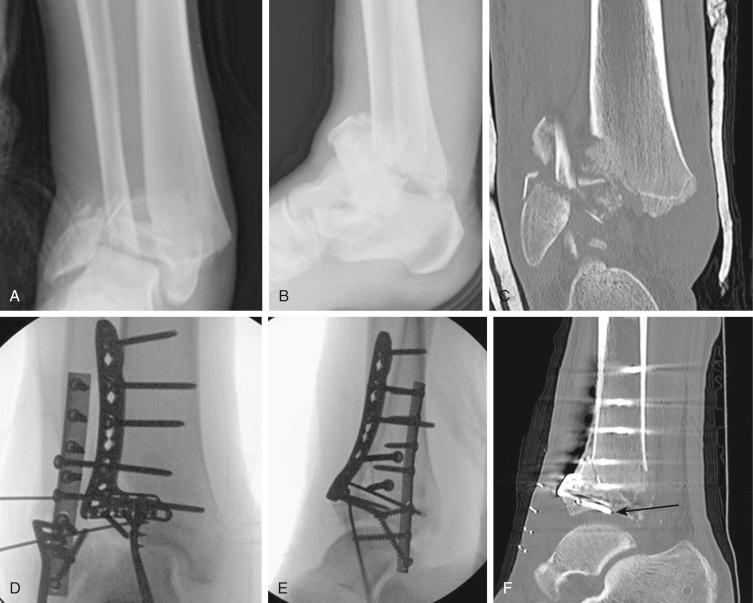
For adolescent pilon fractures, the authors recommend CT scan for detailed evaluation of intraarticular fractures, diligent assessment of the soft tissues, and appropriate timing for definitive fixation. If there is excessive soft tissue swelling, definitive fixation should be delayed for 10 to 14 days until the swelling subsides and the “wrinkle” test is present. Patients need to be counseled preoperatively regarding possible complications like wound healing, infection, nonunion, malunion, growth arrest, stiffness, and osteoarthritis.
The juvenile fracture of Tillaux and triplane fractures are considered to be transitional fractures. These fractures occur in and about the early part of the second decade during the pubescent transition to skeletal maturity. They occur as a result of an external rotational force. The pattern of closure of the distal tibial physis (i.e., middle, medial, and lateral) is responsible for propagation of the fracture after injury.
The juvenile fracture of Tillaux is an isolated fracture of the lateral portion of the distal tibial epiphysis ( Fig. 15.23 ). With external rotation, the anterior tibiofibular ligament holds firmly to the tibial epiphysis, which separates through the junction of the middle and lateral open physis. When displacement of the fragment is minimal, the vertical and horizontal fracture lines may be difficult to visualize. It is a Salter-Harris type III epiphyseal fracture, and mild or moderate displacement of the fragment may be present. The pattern of the injury is thought to result from the closure sequence of the distal tibial physis.
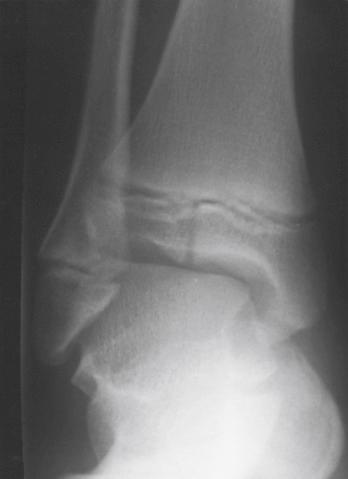
The distal physis of the tibia closes first on its medial half at the age of 13 or 14 years; the lateral part closes at 14.5 to 16 years. Closure of the distal tibial physis occurs first in the middle, then in the medial, and finally in the lateral physis ( Fig. 15.3 ). Because the lateral physis is still open, the fracture crosses through it. The fracture line extends from the articular surface proximally; it traverses the epiphysis and then continues along the physis laterally. It is equivalent to the Tillaux lesion in adults. Local tenderness and swelling may be seen over the anterolateral aspect of the distal tibial epiphysis.
For truly nondisplaced fractures, conservative treatment using cast immobilization is preferred. Close follow-up and weekly radiographs should be obtained to make sure that the fracture does not displace once swelling subsides. CT scan can provide an accurate assessment of true displacement, which can help with treatment decisions ( Fig. 15.24 ). CT can also help for surgical planning of size and trajectory of screw. For displaced fractures, closed reduction should be performed in the operating room by gentle internal rotation of the foot. If closed reduction is successful, the authors recommend percutaneous fixation with a 4-mm partially threaded, cannulated screw. K-wires could be used for definitive fixation if the fragment is small or comminuted. A below-knee non-weightbearing cast is applied for 3 to 4 weeks. If closed reduction is not satisfactory, open reduction with transfixion may be required. The screw can cross the physis in this particular situation because the middle and medial sections of the growth plate are usually closed ( Fig. 15.24 ). If the growth plate is not closed or closing, the implant should not cross the physis. Growth discrepancy is an unusual sequela of this injury because most of the physis has closed. The more significant complication is nonunion or arthritis resulting from either a step-off of the articular surface or a residual gap greater than 2 mm.
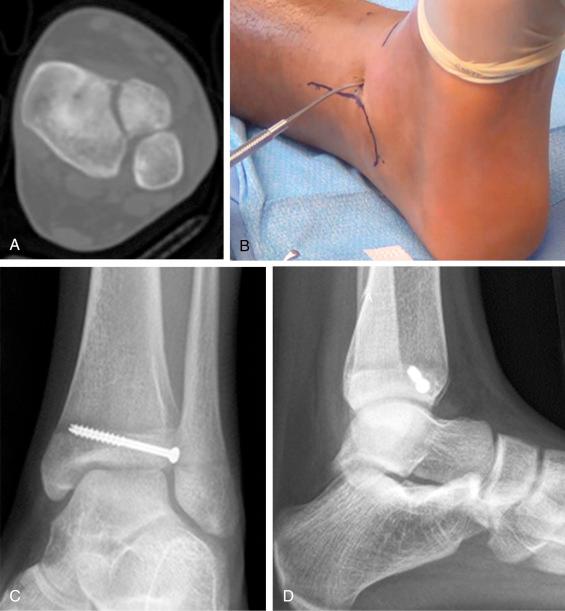
A triplane fracture is an injury unique to the closing distal tibial growth plate. The fracture line crosses the articular surface through the epiphysis, the physis, and finally the posterior tibial metaphysis in the sagittal, transverse, and coronal planes, respectively. The multiplanar Salter-Harris type IV injury created is thought to be caused by external rotation of a supinated foot. The triplane fracture occurs earlier in adolescence than the juvenile Tillaux fracture because the epiphyseal plate is still completely open in early adolescence, thus allowing the horizontal fracture to run through its entire anterior portion. In the older group, the growth plate’s medial area has already closed, so the horizontal break extends only through its anterolateral portion and is met by the vertical fracture near the closed medial epiphyseal line.
Triplane fractures of the distal end of the tibia are sometimes quite difficult to identify on plain radiographs. AP, lateral, and mortise views should be taken. The fracture appears to be a Salter-Harris type III injury on the AP view and a Salter-Harris type II injury on the lateral projection ( Fig. 15.25 ). In the AP projection, the fracture can be seen as a vertical line crossing the central area of the epiphysis, with widening of the mortise. The appearance in this projection is remarkably similar to that of a juvenile Tillaux fracture, and care must be taken not to confuse the two. Mortise views may show more displacement than the AP ones. The apparent Salter-Harris type II fracture seen on the lateral view may be minimally displaced and occasionally obscured. It may be misinterpreted as fibula fracture at times. This radiographic fracture pattern in a growing child should always suggest a triplane fracture. An associated fibular fracture has been shown to occur in 37% of triplane cases (40 of 107 cases). CT studies have simplified identification of all facets of this injury. Depending on closure of the distal tibial physis, the fracture may consist of one, two, or three fragments in addition to the tibial shaft ( Table 15.2 ). Thus triplane fractures are said to come in two-part, three-part, and four-part varieties. Data from five published series of triplane fractures reveal that two-part fractures are the most common, representing 60% of cases (85 of 141), three-part fractures comprise 38% (53 of 141), and four-part fractures occur only in 2% of cases (3 of 141).
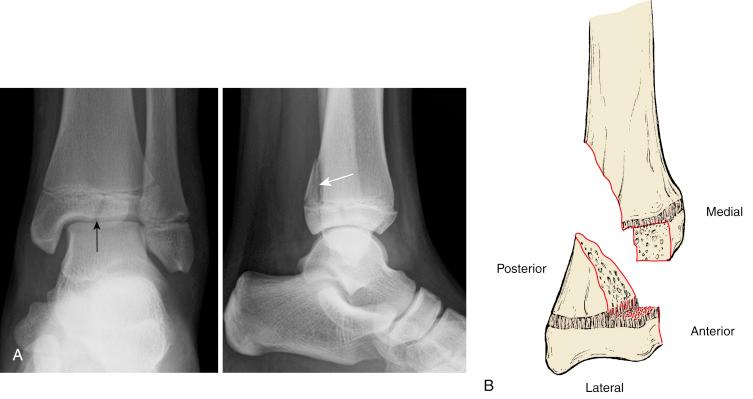
| Author | Year | Two-Part | Three-Part | Four-Part | Fibula |
|---|---|---|---|---|---|
| McNealy et al | 1982 | 14 | 5 | 0 | ? |
| Ertl et al | 1988 | 4 | 11 | 0 | ? |
| Rapariz et al | 1996 | 12 | 23 | 0 | 17 |
| El-Karef et al | 2000 | 12 | 6 | 3 | 5 |
| Brown et al | 2004 | 43 | 8 | 0 | 18 |
| Totals: | 85/141 | 53/141 | 3/141 | 40/107 | |
| % | 60% | 38% | 2% | 37% |
Denton and Fischer described a medial triplane fracture caused by adduction and axial loading. Kärrholm stated that such a fracture type occurs at a low peak age and is associated with complications such as medial growth retardation or arrest, and they stressed that it should not be confused with other types of triplane fractures. Lutz Von Laer has quite appropriately stated that a transitional fracture such as the triplane fracture “strains the spatial imagination of the surgeon.” Several authors have summarized the major triplane fracture patterns, and these findings are illustrated in Fig. 15.26 .
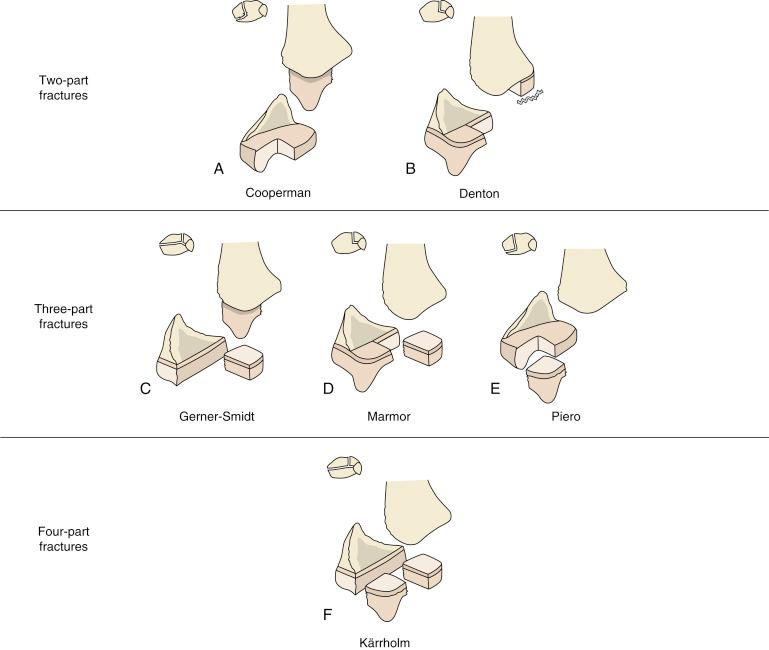
Intramalleolar triplane fractures have been reported. Shin and associates published a classification of intramalleolar triplane fractures and pointed out that three-dimensional CT has great advantages over plain radiographs and two-dimensional CT for evaluating this injury. They described three classes: intraarticular fracture at the junction of the tibial plafond and medial malleolus (type 1), intraarticular fracture of the medial malleolus (type 2), and extraarticular fracture (type 3), which is the most prevalent. Operative reduction is required when intraarticular incongruity exists. The extraarticular triplane fractures that extend through the medial malleolus (instead of tibiotalar joint) can be treated nonoperatively with satisfactory outcomes ( Fig. 15.27 ).
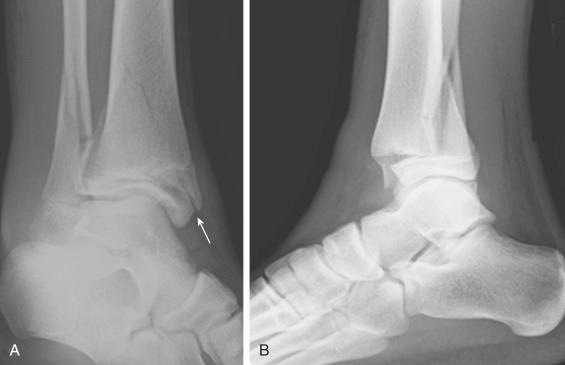
Ertl and associates completed a long-term (3- to 13-year) follow-up of this intraarticular fracture and found that it led to significant arthritis in adults when less than anatomic reduction was achieved. Although symptoms were absent on early follow-up, about half their patients were symptomatic at long-term evaluation. Kärrholm published the results of 21 of his cases with a 4-year follow-up and a review of the literature (209 cases); in total, about 80% displayed excellent results, 16% had minor symptoms, and 4% had more pronounced symptoms combined with degenerative changes. When the epiphyseal fracture extended into the weightbearing arch of the ankle, residual displacement of greater than 2 mm was associated with suboptimal results. In Rapariz and associates’ series, of the 35 patients treated for triplane fractures, the only two patients in whom degenerative changes were seen in their ankle radiographs were those with residual intraarticular displacement of 3 mm. Anatomic reduction by either closed or open means is mandatory in the treatment of triplane fractures.
The choice between open and closed reduction depends on the amount of residual displacement after reduction. Impending growth arrest is not usually a consideration because the growth plate is approaching closure. Even though this fracture seems to be intrinsically unstable, it is only at the articular surface; where permanent disruption definitely predisposes to degenerative joint disease, that loss of reduction is crucial. Anatomic reduction of the articular surface is mandatory. Ertl and associates found that none of their patients with initial displacement of greater than 3 mm on AP or mortise radiographs had successful closed reduction. Interposition of soft tissue at the fracture site was responsible for the failure of closed reduction in six of eight open operations. The soft tissue was identified as periosteum in five patients and was found to be the extensor hallucis longus tendon in one. A diastasis or step-off of more than 2 mm in any plane at the articular surface requires anatomic reduction.
General anesthesia is required for complete relaxation. The knee is flexed to 90 degrees, and the foot is plantar flexed and internally rotated. If anatomic reduction is achieved, percutaneous partially threaded 4-mm cannulated interfragmentary screws are placed ( Fig. 15.28 ). Preoperative CT scan can help in planning for percutaneous placement of screws. The axial cut through the epiphysis helps to plan for the intraarticular fracture reduction and fixation. The axial cut above the physis helps to plan the trajectory of the metaphyseal screw. Pointed reduction clamps could be used to maintain reduction during percutaneous fixation. Usually, a lateral to medial epiphyseal screw is placed first for fixation of the intraarticular Tillaux part of the triplane fracture. Next, a metaphyseal screw is placed from anterior to posterior for stabilization of the posterior metaphyseal fragment that is visualized on lateral view. The trajectory of these two screws are nearly perpendicular to each other. More screws can be placed depending on the size of the fracture fragments. The extremity is placed in a non-weightbearing below-knee cast for 4 weeks.
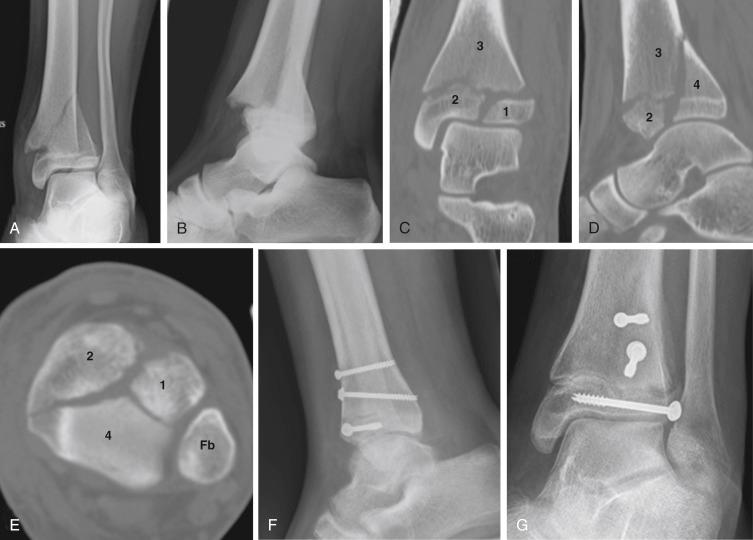
If the intraarticular gap after reduction is greater than 2 mm, open reduction is necessary. Open reduction is not easy and may require anterolateral and posteromedial approaches to reduce the fractures under direct visualization. Only after the posteromedial fragment is reduced can the anterolateral (Tillaux) fragment be reduced. Through an anterolateral approach, the anterolateral fragment is identified and displaced. The posteromedial fragment, if displaced, is first reduced under direct visualization by internal rotation and dorsiflexion of the foot. When reduced, the posteromedial fragment is typically fixed with a cannulated screw. If the posteromedial fragment cannot be reduced by manipulation, it should be reduced under direct visualization through a posteromedial incision. If displaced, the fibular fracture is reduced next. Finally, the displaced anterolateral fragment (Tillaux) is reduced and fixed with a cannulated screw ( Fig. 15.29 ). A non-weightbearing, below-knee cast is placed for 4 weeks. In a recent study comparing percutaneous fixation (17 patients) to open reduction and internal fixation (48 patients) for transitional fractures, there were significantly higher rate of complications from open surgery (19% vs. 0%); these complications included symptomatic hardware, nerve/muscle injury, persistent pain, and infection.
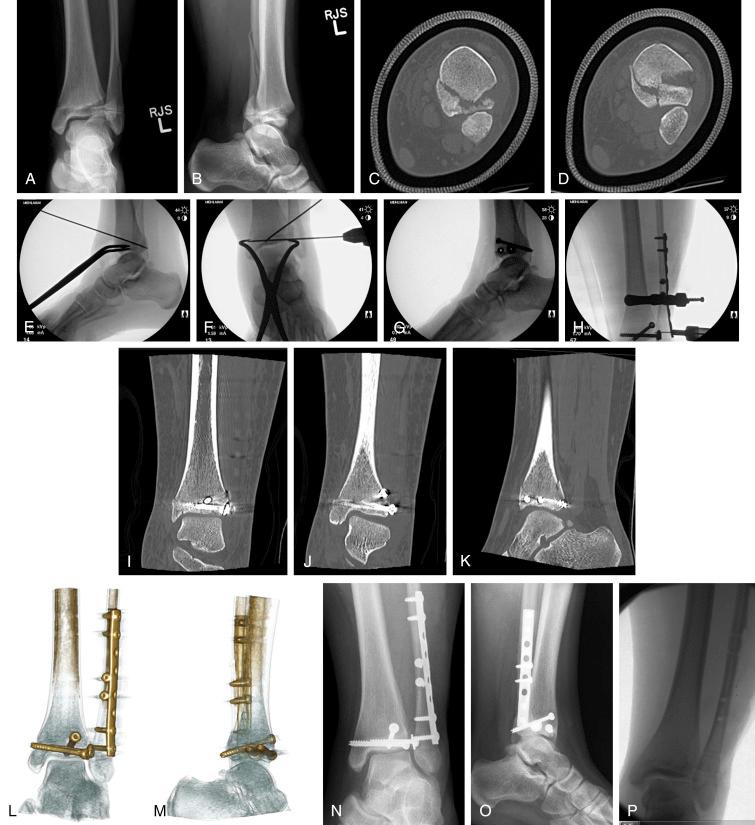
Distal tibial growth is nearly complete when this injury occurs, so shortening from growth arrest is rarely a problem. Ertl and associates’ long-term reevaluation showed marked deterioration with time in ankles in which reduction of the articular surface was not accomplished. At an average of more than 6 years after injury, the result was that 15 patients had declined at least one grade. None of these patients improved during follow-up after injury to the articular cartilage. Even in individuals with anatomic reduction, delayed long-term symptoms still occurred. The symptomatic patients monitored for 20 years were only in their third decade and could experience continued deterioration. Residual 2- to 3-mm displacement of the articular cartilage in the weightbearing area may result in late-onset degenerative arthritis.
Choudhry et al evaluated functional outcomes after treatment of 78 transitional fractures (58 triplane and 20 Tillaux fractures). Some 60% of patients had closed reduction and percutaneous fixation, 33% had closed reduction, and 5% had open reduction and internal fixation. They reported good medium-term outcomes when the residual gap or step off was less than 2.5 mm, and these results did not deteriorate at longer-term follow-up (4–10 years).
Syndesmotic injuries in children are rare, but they do occur. Study of normative radiographic values of syndesmosis in children showed that the medial clear space could not be reliably assessed in children less than 8 years of age because of insufficient ossification of medial malleolus. Similarly, lack of tibiofibular overlap (less than 6 mm is considered abnormal in adults) and increased tibiofibular clear space (more than 6 mm is considered abnormal in adults) could be normal in children because of delayed ossification of incisura fibularis. Sung et al performed radiographic measurements on 590 children and concluded that the criteria for absolute radiographic values used in adults to assess the syndesmosis could not be applied to children, but these values should be compared with the contralateral side. If there was more than 50% difference in the values for tibiofibular overlap, tibiofibular clear space, and medial clear space on comparison radiographs of opposite ankle, then further imaging (MRI or CT) should be performed to confirm the diagnosis.
For management of syndesmotic injuries in children and adolescents, it has been reported that presence of fibular fracture, medial clear space greater than 5 mm, and closed tibial physis had 44 times, 8 times, and 5 times the odds of requiring surgical intervention, respectively. For surgical fixation, there are lack-of-outcomes studies or comparison studies to recommend suture-button fixation over standard screw fixation of syndesmosis in children.
Jarvis and Miyanji reported on six patients with distal tibial triplane fractures in conjunction with completely separate (noncontiguous) fractures of the ipsilateral tibial shaft. The average age at the time of injury was 14 years, which is the typical age for a transitional fracture of the ankle. Contrary to conventional thinking, all injuries were secondary to low-energy falls. All tibial shaft fractures were midshaft spiral or short oblique and were minimally displaced. Similarly, all but one triplane fracture were minimally displaced (gap, <2 mm). Diagnosis of the distal triplane fracture was delayed in two cases. Although all patients in the study were treated satisfactorily with closed reduction and casting with the ankle in internal rotation, the treatment may vary based on patient and fracture characteristics. The authors have treated five patients with this combination and would recommend focused ankle examination in an adolescent with a tibial shaft fracture and dedicated ankle radiographs for suspected injuries ( Fig. 15.30 ). Because of the injury’s potential for long-term sequelae, a high index of suspicion should be maintained so that the ankle fracture is not missed.
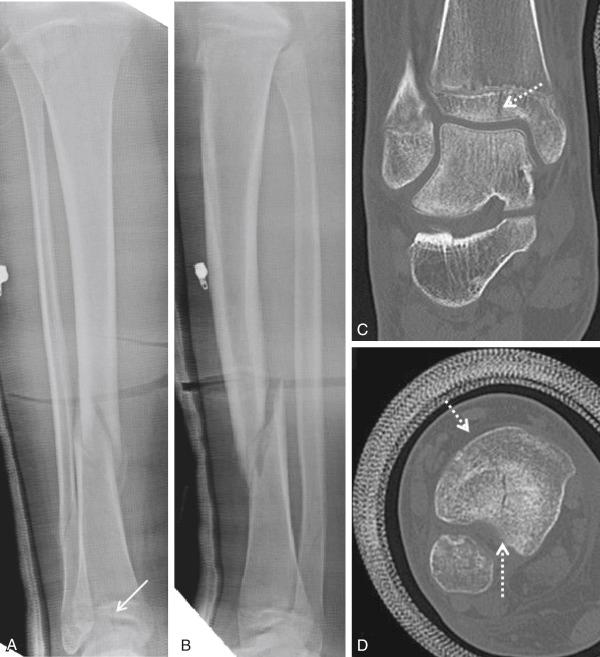
Become a Clinical Tree membership for Full access and enjoy Unlimited articles
If you are a member. Log in here